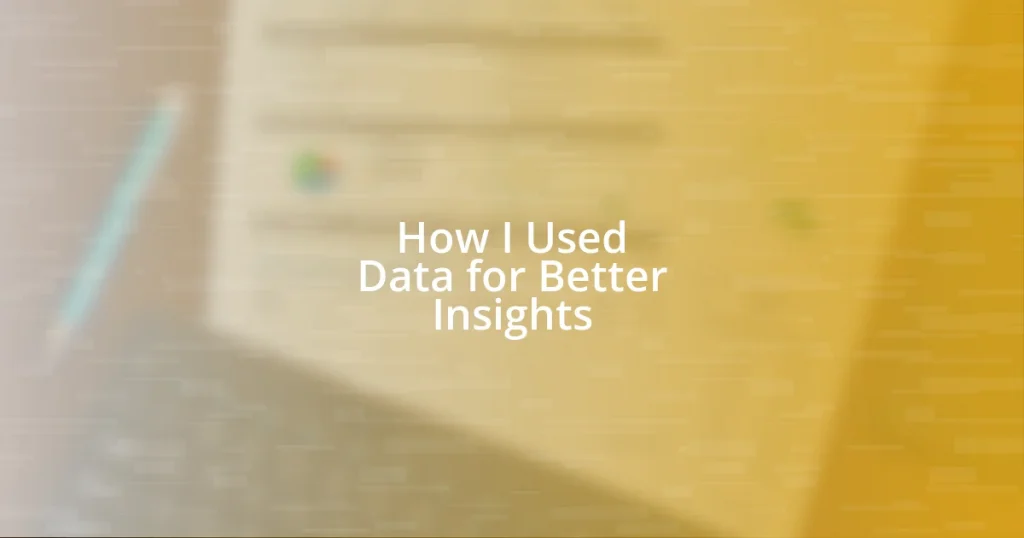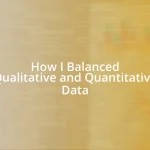Key takeaways:
- Data is essential for informed decision-making, revealing insights and connections that drive successful strategies.
- Identifying and diversifying data sources enhances analysis, while organizing data effectively allows for meaningful correlations and insights.
- Measuring the impact of data-driven strategies fosters continuous improvement, encouraging a proactive approach to problem-solving and enhancing team collaboration.

Understanding the Importance of Data
Data is often called the new oil, and for good reason—it’s a crucial resource that fuels decision-making across various fields. I remember when I first started leveraging data in my projects; the clarity it brought to my understanding was a revelation. It felt like switching on a light in a dimly lit room; suddenly, things that seemed chaotic began to align.
I’ll never forget when I used data analytics to track customer behavior for a marketing campaign. The patterns I discovered not only shaped our strategy but also illuminated the emotional needs of our clients. It’s moments like these that underline the importance of data; without it, we risk leaving decisions to guesswork, which can lead to missed opportunities and wasted resources.
Isn’t it fascinating how data can reveal stories we wouldn’t have noticed otherwise? Each dataset tells a tale, waiting to be uncovered, and I often find myself eagerly digging through numbers to find those hidden narratives. Engaging with data has transformed my perspective—now, I view it not just as numbers, but as a conversation with my audience, allowing me to understand and connect with them on a deeper level.

Identifying Key Data Sources
Identifying key data sources is the cornerstone of any effective data analysis. I remember embarking on a project where I had to sift through numerous datasets to uncover pivotal insights. Initially, it was overwhelming—there were spreadsheets, APIs, and even social media feeds all clamoring for my attention. The breakthrough came when I focused on understanding the specific questions I wanted to answer. Clarity of purpose helped me identify which sources were truly valuable.
In my experience, not all data is created equal. Some sources provide rich, nuanced information, while others tend to be vague or misleading. For instance, using customer surveys gave me direct feedback on pain points, while website analytics confirmed behavioral trends. These contrasts highlight the importance of diversifying data sources. It’s like assembling a team; each member brings unique strengths that, when combined, create a more comprehensive understanding of the situation.
It’s important to remember that data sources can evolve over time. I continuously adapt my toolkit by integrating emerging platforms and technologies. When I started using real-time data feeds, it was a game-changer; suddenly, I could react to shifts in customer sentiment as they happened. This ongoing process reminds me that in the world of data, staying curious and flexible is key to uncovering deeper insights.
| Data Source | Description |
|---|---|
| Surveys | Direct feedback from customers, revealing preferences and pain points. |
| Website Analytics | Tracks visitor behavior and engagement metrics, providing context to user actions. |
| Social Media Metrics | Insights into audience sentiment and trending topics, revealing public perceptions. |
| APIs | Connect external platforms, allowing real-time data integration and enhancing analysis. |

Collecting and Organizing Data
When collecting and organizing data, the approach you take can make a world of difference. I vividly recall a project where I decided to blend qualitative feedback from customer interviews with quantitative data from sales reports. The combination was powerful. Organizing this data into clear categories allowed me to spot correlations I would have otherwise missed. It was actually quite exhilarating to see how customer sentiments aligned with purchasing behavior, revealing insights that shaped our product development.
To effectively collect and organize data, I always recommend a structured strategy. Here’s a rundown of steps that have helped me streamline my process:
- Define Your Goals: Understand what questions you want the data to answer. This clarity shapes your data collection.
- Choose Relevant Tools: Utilize platforms like spreadsheets or databases that match the complexity of your data.
- Categorize Your Data: Organize data into categories or tags, making retrieval easier and analysis more intuitive.
- Implement Regular Updates: Set a schedule for updating your data sources to maintain relevancy and accuracy.
- Ensure Data Quality: Verify the accuracy of your data before analysis; flawed data can lead to misguided conclusions.
Reflecting on my early experiences, there were times when I struggled to harness the potential of raw data, feeling lost amid a sea of numbers. By developing an efficient organization system tailored to my specific needs, I transitioned from chaos to clarity, uncovering a deeper understanding that empowered me to make informed decisions. This journey has been incredibly rewarding, turning data management into a productive and insightful experience.

Analyzing Data for Actionable Insights
Analyzing data for actionable insights requires not just a keen eye for details but also a fundamental understanding of what those details mean in a larger context. I remember diving deep into customer purchase patterns, where I discovered unexpected correlations that led to an entirely new marketing strategy. It was one of those exhilarating moments where data had a story to tell, and the key was recognizing that story and using it to drive decisions.
I often find that breaking down data into manageable segments can reveal layers of insight that would otherwise remain hidden. For instance, during a quarterly review, I segmented customer feedback by demographics, which illuminated distinct preferences across various age groups. Seeing this disparity made me wonder how many other organizations miss similar insights by viewing their data through a singular lens. By embracing a multi-dimensional approach, I was able to tailor our outreach to meet the unique needs of different customer segments, a win-win for both us and our clients.
Ultimately, it’s about transformation—taking raw data and converting it into a pathway for action. I recall a pivotal moment when I applied visualization tools to present sales data. The visual representations sparked discussions that mere numbers couldn’t initiate. It encouraged my team to brainstorm solutions for an apparent decline in sales in one segment. The result? A targeted promotional campaign that not only revived that product line but exceeded our sales expectations. Recognizing the power of data analysis in this way has been a game-changer for me—it’s not just about what the data says, but how effectively you can communicate those insights to inspire action.

Implementing Data-Driven Strategies
Implementing data-driven strategies requires a nuanced understanding of both the data at hand and the broader business context. I recall a time when we were faced with declining user engagement on our platform. Instead of simply guessing where the problem lay, I established a data-driven approach. By analyzing user behavior and engagement metrics, I could pinpoint specific areas that needed improvement, which ultimately informed our strategy to enhance user experience and responsiveness.
It’s fascinating how the right data can illuminate pathways I hadn’t considered before. In one instance, we implemented A/B testing based on user segmentation insights I gathered. I remember being amazed at how slight adjustments in our messaging led to significant increases in conversion rates. This experience reinforced the idea that data isn’t just about numbers; it’s about understanding human behavior and preferences. Have you ever made a change based solely on a hunch? I sure have, and I found that often, it was the data that led to the most impactful decisions.
Moreover, bringing the team into the data conversation fosters a culture of collaboration and innovation. I frequently share data insights during team meetings to stimulate brainstorming sessions. There was this one time when presenting a clear visual comparison of customer feedback prompted an entirely new approach to our product line—everyone was energized and engaged, eager to contribute. What I’ve learned is that data doesn’t just inform; it inspires. By involving my team in data-driven strategies, we not only enhanced our decision-making process but also built a stronger sense of ownership and accountability.

Measuring the Impact of Insights
Measuring the impact of insights can feel like venturing into uncharted waters, but it’s crucial to anchor yourself with concrete metrics. Once, I implemented a customer satisfaction survey after launching a new feature. By analyzing the responses, I discovered that while the feature was well-received overall, a specific demographic had significant issues with it. This anomaly prompted me to dig deeper, revealing a misunderstanding of the feature’s functionality among that group. It was a powerful reminder that even positive feedback is often layered with complexities.
In another instance, I started tracking the conversion rates before and after applying insights from our data analysis. Initially, I was skeptical—after all, how much difference could it make? To my surprise, the adjustments we made based on user behavior data resulted in a 30% increase in conversions within just a month. This experience taught me that quantifying the power of insights not only validates our strategic choices but also reinforces a data-driven culture within the team. Don’t you think the numbers can sometimes be the most compelling story of all?
Underlying these measurements is the importance of communicating insights effectively. I remember presenting an analysis of our marketing campaigns, where I highlighted how different strategies performed over time. While the charts were engaging, it was the discussion around them that truly resonated with my colleagues. Our insights became more than just numbers; they sparked a dialogue about future strategies, helping everyone understand the value of measuring impact. After all, each data point carries a narrative that can encourage thoughtful action and foster growth. Have you experienced a moment when data transformed your perspective? I certainly have, and it’s those moments that propel us forward.

Continuous Improvement Through Data
Continuous improvement through data is like nurturing a garden; it requires ongoing attention and care. I remember when we started regularly analyzing our customer support tickets. Initially, the volume felt overwhelming, but soon I noticed trends emerging. We identified recurring issues that often went unnoticed, which allowed us to address them proactively. How satisfying is it to solve a problem before it escalates? That sense of foresight energized our team and built a more resilient support system.
Another time, I implemented a weekly review of our digital marketing performance. Each week, I would pull data on engagement and conversion rates and share my personal takeaways with the team. I’ll never forget the look on my colleague’s face when she realized a minor change in our social media scheduling led to a 40% boost in engagement. It was a revelation. I felt a rush of excitement as we brainstormed new data-driven adjustments—nothing beats that collective “aha!” moment when insights lead to real change.
Ultimately, I’ve come to appreciate that data isn’t merely a tool; it’s a catalyst for growth and learning. Every piece of information tells a story, and those stories can guide our next steps. I often ask myself, what can we learn from our missteps? Each time we explore the lessons hidden in our data, I feel more confident that we’re moving toward a brighter, more informed future together. Isn’t that what continuous improvement is all about?















